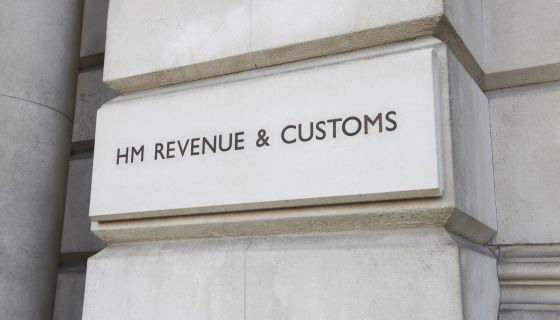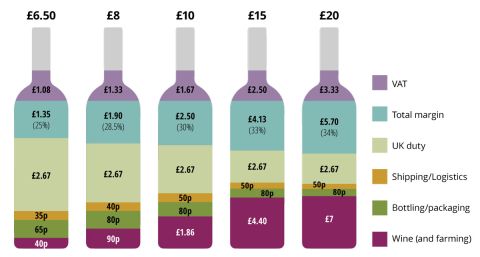As I outlined a couple of weeks ago in Wine – feeling the heat, UK duty on wine above 10.5% alcohol is about to go up – substantially in the case of wines at 15% and over, which means all sherries and ports.
These alcohol-related duty rises of between a penny and 97p a bottle in general won’t make much difference to the price of really expensive wine but will have a massive effect on most wines on supermarket shelves – and possibly on British drinking habits overall. Wine was already losing ground to beer, spirits, cocktails and abstinence. This trend is likely to continue in the wake of substantial price rises for the sorts of wine that constitute the great majority of bottles sold in the UK.
Gavin Quinney of Ch Bauduc in Entre-Deux-Mers, who provides such brilliant Bordeaux vintage reports for us, has come up with a powerful graphic that illustrates the effect of these duty rises.
The graphic above shows that on a bottle retailing at £6.50, probably only 40p will go on the wine itself, including growing it. And even a bottle of wine costing £20 may well contain only £7-worth of wine. It is therefore worth spending a bit more per bottle if you care about the quality of what’s in it, but it’s still galling for us British wine lovers to see so much of what we spend going straight to His Majesty’s Revenue & Customs. (Total margin, estimated here by Quinney at 25–34%, presumably includes the margin levied by retailers, brokers and any other outfits along the distribution chain.)
As if this weren’t crippling enough for the UK wine trade, from 1 February 2025 further duty rises are planned on the great majority of wines that are between 13 and 15% alcohol, by 10p a bottle for wines at 13% and up to 42p a bottle for wines at 14.5%. (Duty on wines at 15% will remain at a massive £3.21 a bottle.)
|
Labelled abv %
|
Duty per bottle until 31 Jul 2023, still/sparkling
|
Duty from 1 Aug 2023 still and sparkling
|
Duty from 1 Feb 2025 still and sparkling
|
% change 1 Aug still
|
% change 1 Aug sparkling
|
|
8.5
|
£2.23/£2.86
|
£1.81
|
£1.81
|
-19
|
-37
|
|
9
|
£2.23/£2.86
|
£1.92
|
£1.92
|
-14
|
-33
|
|
9.5
|
£2.23/£2.86
|
£2.03
|
£2.03
|
-9
|
-29
|
|
10
|
£2.23/£2.86
|
£2.13
|
£2.13
|
-4
|
-26
|
|
10.5
|
£2.23/£2.86
|
£2.24
|
£2.24
|
1
|
-22
|
|
11
|
£2.23/£2.86
|
£2.35
|
£2.35
|
5
|
-18
|
|
11.5
|
£2.23/£2.86
|
£2.67
|
£2.45
|
20
|
-7
|
|
12
|
£2.23/£2.86
|
£2.67
|
£2.56
|
20
|
-7
|
|
12.5
|
£2.23/£2.86
|
£2.67
|
£2.67
|
20
|
-7
|
|
13
|
£2.23/£2.86
|
£2.67
|
£2.77
|
20
|
-7
|
|
13.5
|
£2.23/£2.86
|
£2.67
|
£2.88
|
20
|
-7
|
|
14
|
£2.23/£2.86
|
£2.67
|
£2.99
|
20
|
-7
|
|
14.5
|
£2.23/£2.86
|
£2.67
|
£3.09
|
20
|
-7
|
|
15
|
£2.23/£2.86
|
£3.21
|
£3.21
|
43
|
12
|
As you can see, duty on sparkling wines and on lower-alcohol wines will actually go down. I have already received news that the alcohol content of certain alcoholic drinks will deliberately be reduced to avoid price rises. As I mentioned in Wine – feeling the heat, this is not so easy with wine – and we may end up with some attempts to reduce alcohol content that also reduce quality. The addition of water to wine, already permitted 'for technological requirements' and believed to be common in, for example, the US and Australia, may well be lobbied for in certain quarters in Europe as the continent gets hotter and drier, by the way. See this recent speculative article and this detailed OIV paper on the addition of water to wine published in December 2021.
While I’m delighted that the duty on sparkling wines and the likes of fruitier Mosel wines will be reduced, I do wonder about the extent to which those reductions will feed through to consumer prices. One thing is certain: UK wine merchants, already grappling with the effects of Brexit, are from today lumbered with even more complicated bureaucracy.
Data in the table were kindly provided by the Wine and Spirit Trade Association, representing over 300 companies producing, importing, exporting, transporting, storing and selling wines and spirits in the UK. Photo credit: Peter Dazeley/Getty Images.














